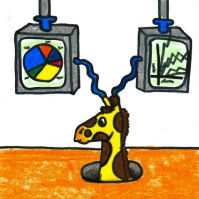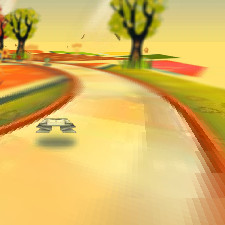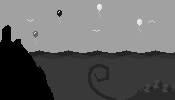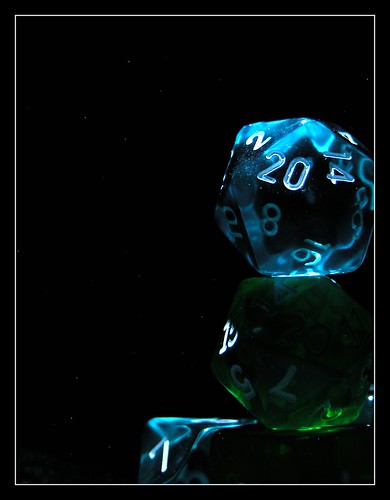I just released my latest game, “I Fell in Love With the Majesty of Colors.” It’s a pixel-horror game that puts the player behind the tentacles of a titanic, writhing sea creature. “Majesty” is a tale of love, loss, and balloons with five different endings.
Category Archives: Digital Games
Puzzle Quest and the Best of Both Worlds
Over at GameSetWatch they just put up my latest column. It’s called “Puzzle Quest and the Best of Both Worlds,” and it’s about genre fusion in the world’s first match-3 RPG.
My Visit to the Land of Dream

I’m a bit miffed. I just finished my latest game, called “Bars of Black and White.” It’s an intentionally roughly-drawn first-person point-and-click puzzling game. To celebrate, I decided to finally play Jonas Kyratzes’s latest game, which to my dismay turned out to be a roughly-drawn first-person point-and-click puzzling game. And it was better than mine.
The Strange and Somewhat Sinister Tale of the House at Desert Bridge is the newest game by the creator of titles like The Museum of Broken Memories and Last Rose in a Desert Garden. Of course, it’s not really a game; it’s a “transdimensional portal to the Lands of Dream,” according to the premise. And it’s a great experience.
Remember when you were a kid and you’d just played Myst and Dare to Dream, and you found Hypercard on your school computers, and you decided to make an adventure game? And it was going to be the coolest game ever, with all sorts of secrets and jokes and you spent hours drawing the backgrounds in a wide-ruled spiral notebook?
Games From a Parallel Dimension

I love games that come from another world. Odin Sphere is a game from a world where 3D never caught on, and people kept making 2D games with more and more advanced hardware. The Fool’s Errand is a game from a parallel universe populated entirely by clumsy geniuses, with brains the size of cities but the tragic inability to play action-oriented games. And Scenic is a game from a dimension where people really loved Mode 7 for some reason. Allow me to elaborate.
Grim Fandango and Diegesis
My latest column was just put up at GameSetWatch. It’s called “Grim Fandango and Diegesis,” and it’s about how that game eschews interface elements that don’t exist in the game world.
The Terror of Choice
As I sat at my desk sketching out a puzzle structure for my next game and listening to the latest episode of Radiolab, “Choice,” I started to think about complexity in goal trees. Just about any game’s structure can be represented as a tree (a partially-ordered set, really) of goals, some of which are required before others.
For the simplest of games, this tree consists of a straight line of nodes labeled something like “Reach Checkpoint 1,” “Reach Checkpoint 2,” and “Beat Boss.” Games with a hint of nonlinearity, however, can often have rather complicated goal trees. The simple tree has a branching factor of one. Each action, or node, has only one successor action. The game Planescape: Torment, on the other hand, has a branching factor of more than ten in some places, such as just after the player reaches the Clerk’s Ward. There are many the player can go or quests she can pursue, each separate and rather complex in its own right.
I’ve been playing The Elder Scrolls IV: Oblivion lately, and that is a game with a branching factor. Each town has four or more quests connected to it, in addition to the main quest, which itself sometimes branches into subquests. Add to this the guilds, of which there are at least four, and the game gets a bit intimidating for me. I hesitate to even mention the plugins and expansions. I walked through the door to the Shivering Isles, a whole new country with its own central plot, towns and sidequests. I think I lasted about fifteen minutes before I retreated back to Cyrodiil, overwhelmed. Oblivion‘s branching factor is a bit too large for my tastes. So what, then, is the optimal branching factor? Let’s look at some examples.
Creating Within a Genre

In the past, I’ve railed against the uselessness of game genres. They’re restrictive and arbitrary categorizations of games, and lead to design decisions being made according to convention rather than the needs of the game. However, sometimes a game is produced that depends wholly on the genre, doing nothing innovative, yet succeeds at being a stellar game in its own right. One of these games is The Curse of Monkey Island.
Integrated Character Creation in Spore
My latest column is up at GameSetWatch. It’s entitled “Integrated Character Creation in Spore“, and it discusses the technique of integrating gameplay with character creation instead of making it a totally separate mode.
Fumbling Critical Rolls and the LORE Approach
Many tabletop roleplaying games and many digital games have a game mechanic called the “critical roll.” With this mechanic, a particularly good skill roll, say a 20 on a 20-sided die, can be a “critical hit,” which is better than a normal success. Likewise, a roll of 1 on a 20-sided die could be a “critical failure,” a “critical miss,” a “fumble,” or a “botch.” Critical failures result in an especially bad outcome.
Critical rolls typically represent the fickle hand of luck. Even in a game where randomness determines every important outcome, it is possible for characters to get especially lucky or unlucky. Sometimes, that arrow flies just right and hits the dragon right in the eye. Critical hits are often a cause for celebration among tabletop roleplayers, and critical misses are moments of frustration and (usually good-natured) anger at the game and the game master. Many digital games that use tabletop RPG-like mechanics also use critical roll systems. Notably, the action-focused game Team Fortress 2 also incorporates this mechanic in the form of random critical shots, which do more damage than normal shots and are more likely the more damage a player does.
Like many tabletop roleplayers, I’m working on a roleplaying system of my own, called LORE. During the development process, I’ve done a lot of thinking about a lot of the common elements of tabletop RPGs, and critical rolls has been one that I’ve focused on. I’ve decided that critical rolls have a part to play in game mechanics, but that there are many pitfalls that should be avoided. Here are my thoughts.
Continue reading Fumbling Critical Rolls and the LORE Approach
The Length of Games and the Frailty of Memory
Recently, GameSetWatch linked to an article at You Are Lose! asking if a long game can tell an engaging story:
When RPGs or strategy games stretch into the dozens of hours, played over many weeks or months, how am I to be expected to recall something that happened in the beginning of the game?
The longer a game, the more likely I am to put it down for a lengthy time and forget major details about it. This is a major detriment, I think, to games’ ability to tell a story.
The author, Korey, makes a certain amount of sense. As he points out, many games will present information in the opening cutscene that’s not referred to again until hours later. In the middle, there’s a whole lot of content going on. However, I think that when interactive narrative is handled properly, works of equivalent scope need to be longer than their non-interactive equivalents. Let’s look at Valve’s Portal first.
Continue reading The Length of Games and the Frailty of Memory

